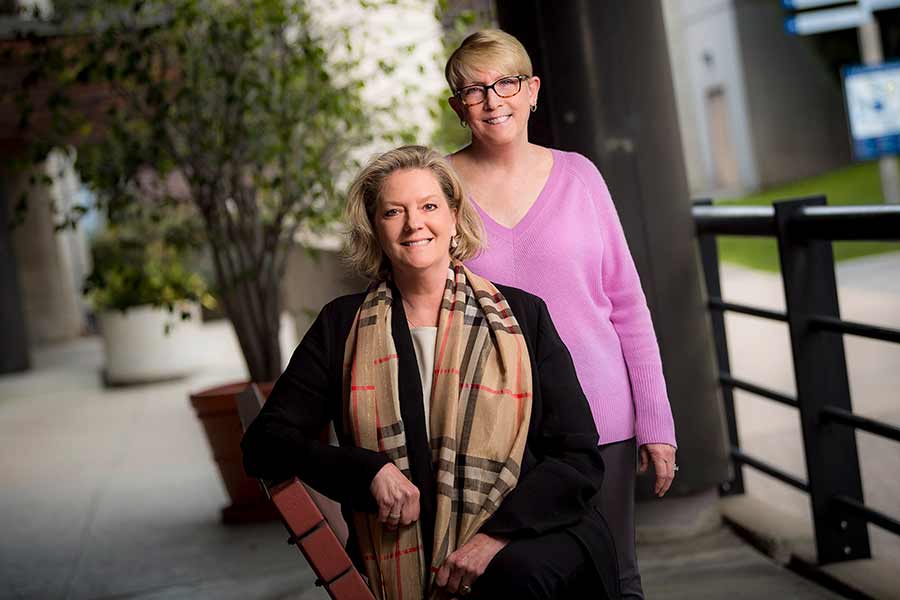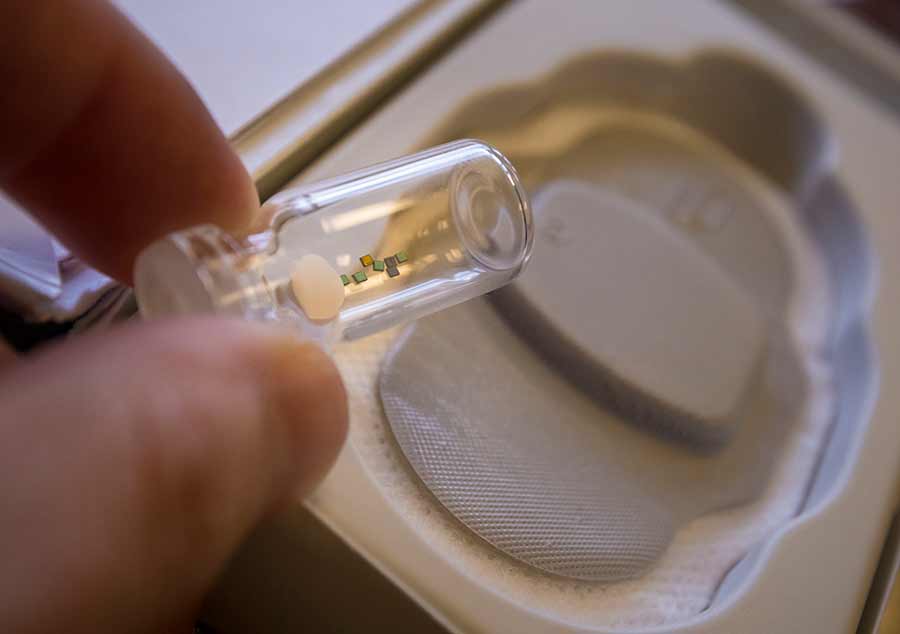
By:
- Alison Caldwell
Published Date
By:
- Alison Caldwell
Share This:
Data for Life
New technologies can support patient privacy and autonomy instead of sacrificing them
As concern grows over the ubiquity of digital tools for patient care and treatment management, it can often seem like the challenges of protecting patient privacy outweigh the benefits. But some researchers at UC San Diego are using technological advances to develop new ways to help patients retain not just their privacy, but also their autonomy and control over their own medical treatment.
For Dr. Sara Browne, that is the most critical aspect of her research. As a professor of clinical medicine, she’s interested in understanding and treating infectious diseases with global health implications—conditions such as HIV and tuberculosis.
For many Americans, “tuberculosis” might sound like something out of a Jane Austen novel; but to think that tuberculosis, or TB, is a disease from a bygone era would be a mistake. Today, it kills about 1.5 million people each year around the world—more than any other infectious disease. In the United States alone, nearly 10,000 people were diagnosed with TB in 2018.

Dr. Sara Browne (left) and Dr. Constance Benson are testing the use of edible medication trackers for long-term tuberculosis treatment
Part of the reason that TB remains a global health concern is because it is challenging to treat, and patients often lose the motivation to finish their medications. “Tuberculosis is curable, but it requires multiple antibiotics taken over long periods of time—a minimum of six months,” said Dr. Amanda Tucker, a clinical research project manager working with Browne. “Often, treatment takes as long as 9 or 12 months. When you feel sick, it’s easy to see the need to take the treatment, but as you improve, it becomes more challenging, and it’s difficult to ensure that patients complete their course of medication.”
As a result, the World Health Organization (WHO) recommends that patients participate in what’s known as directly observed therapy, or DOT. Under DOT, while patients are recovering from TB, health care providers meet with patients once per day to watch them consume their medications and record the treatment. This approach allows providers and patients to work together to ensure that patients complete their full course of medications—but it has its downsides.
“With DOT, health care workers have to drive to your house and watch you take the medications,” said Browne. “But that means that a patient has to be available to meet at a certain time, and the neighbors might notice and start asking questions—it’s a huge inconvenience, and it makes it tough for patients to preserve their privacy over their medical treatment.”
DOT is currently considered the highest standard of care for TB; it’s the most accurate way of determining whether or not patients are following their treatment. Even so, here in the U.S., DOT only tracks patient’s medication adherence about two thirds of the time, because most health care workers don’t perform these home visits on the weekend.
“Even beyond that, DOT doesn’t track whether or not the medication was ingested,” said Dr. Constance Benson, a professor of medicine and global public health at UC San Diego Health. “There are numerous reports indicating that even when a health care worker watches a patient take pills, patients can avoid actually swallowing the pills until they are no longer under observation and can then remove the pills from their mouths.”
So, Browne and Benson started looking for technical solutions to the challenge, and approached a tech company to talk about a collaboration. That’s what led their team in the UC San Diego AntiViral Research Center to their most recent research study.
In the study, published in PLOS Medicine on Oct. 4, 2019, Browne and her colleagues tested a new treatment approach called wirelessly observed therapy, or WOT. Under WOT, patients wear a small electronic patch on their skin; then, alongside their medications each day, they swallow a tiny, edible sensor. The electronic patch records exactly when a patient takes their medication, sending that information to an app, where patients can track their adherence and send that data to health care providers.
When Browne and Benson’s team tested the WOT technology with TB patients in Orange and San Diego Counties in California, the difference was staggering. Because WOT could track medication doses over the weekend, it had a 93 percent dose recording rate, compared to only 63 percent with DOT. Even more noticeable, however, was how much the patients preferred the WOT treatment over DOT—so much so that the researchers had a difficult time getting patients to return to the original DOT treatment when the study called for it. Instead, they had to give special permission to health care providers to allow patients to continue on WOT.
“The feedback was almost universally positive,” said Browne. “The most serious side effect was a slight rash on the skin from the glue used for the sensor. This device gives patients much more autonomy and privacy, and lets them see how they’re doing with taking the treatment and seeing what percentage they have left.”
The advantage of WOT over other kinds of tech is that, unlike reminder text messages or programmable pill boxes, the edible sensor actually detects medication consumption, making it more accurate at detecting when a patient takes their meds. But more than that, WOT represents an opportunity for patients to take back control over their medical treatment.
“Swallowing the pills is not the only step in supporting adherence to medications,” said Benson. “Patients need to be able to communicate when they are having trouble with the pills or when they are having side effects from the medications, and being able to text or email directly from the digital systems may help patients keep in closer touch with their clinicians about these issues.”
“This is a self-management device, aimed at patients,” said Browne. “Patients own the data, and have to give permission to share it with their providers – it allows them to be more in control of their condition, and have better conversations with their providers.”
Browne and Benson’s team isn’t the only group at UC San Diego interested in developing new tools to help patients take control of their medical treatment. The Department of Electrical and Computer Engineering (ECE) in the Jacobs School of Engineering hosted a 2019 Design Competition for their students, with the goal of developing new tools to improve quality-of-life for patients and caregivers of Parkinson’s Disease. One team took that goal and ran with it.

The edible sensor used by Browne et. al. is smaller than a pill. When swallowed, it communicates directly with an electronic patch on the skin, recording each time a patient takes their medication and sending the information to an app.
“We spent three months talking to patients and doctors before we even started designing,” said team leader Po Huang, a third year undergraduate. “What we found was that lots of patients had experienced misdiagnosis early on in their journey with Parkinson’s Disease, and felt like they had a hard time communicating their habits and symptoms to their doctors.”
That feedback led Huang and his team to develop a new app that patients and caregivers can use to help track the condition. In the app, patients can scroll through a list of symptoms and select which ones they’re currently experiencing, and log the severity of the symptoms. They can also send messages directly to health care providers, allowing doctors to track patient progress and determine if treatment needs have changed.
“We’ve gotten really positive feedback from doctors and patients,” said Huang. “Patients feel like tracking their symptoms gives them a lot of control in their lives. They can document their feelings each day, and make adjustments based on that information to help them feel better. They can also track if certain activities or behaviors make them feel worse, and avoid doing those things in the future. It lets patients test out what works best for them.”
The app is still in development. Right now, Huang’s team is working on launching a beta version of the app, and applying for funding opportunities to support its growth. Part of their next steps will be navigating patient privacy issues, and finding a platform that will effectively protect patient data; they hope to eventually get the program approved by the U.S. Food and Drug Administration (FDA), so it can be used widely by Parkinson’s patients and their health care providers.
Similarly, Browne’s work on using WOT to manage TB treatment is in its early days, but she is excited about the possibilities. “Our study only looked at one part of the treatment course, and we need to figure out if this will work over the entire course of treatment,” she said. “But once this tech is set up, it should work anywhere. We tested this system in a high-income area, where DOT is relatively easy to provide. This could change how health care providers track medication adherence in low- and middle- income countries, where DOT is harder to manage.
“People are adept at using digital technologies already. This will let patients use this technology for their own health care management. They are already teaching us new things about this system – for example, some patients in other trials are ‘gameifying’ the WOT, trying to see how many days they can go in a row without missing a dose, taking their doses at the same time every day, and so on. We’re all still learning, but I really want to make sure that we can support patients in these activities.”
Like Browne, Huang also wants to see patient support technology take off. “I really want to get this off the ground,” he said. “Patients have been really excited about and supportive of the project, and we’d like to make it accessible to more people.”
Long term, these technologies can be expanded for use in a wide variety of conditions and treatments and may even reduce treatment cost. “Although upfront costs of digital technology are sometimes used as a reason to avoid using them for monitoring therapy, ultimately the use of digital technology directly by patients and their clinicians may reduce the costs of hiring health care workers to conduct directly observed therapy,” said Benson. “We’re working on many potential applications, including antiretroviral therapy for people living with HIV, and in the future we hope to use the technology for monitoring side effects, particularly related to heart rhythm and EKG abnormalities, of new TB treatments being used in combination in clinical trials aimed at developing new regimens. The technology isn’t there yet, but we’ll get there soon.”
Share This:
You May Also Like
Stay in the Know
Keep up with all the latest from UC San Diego. Subscribe to the newsletter today.


